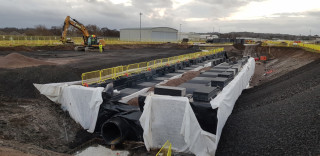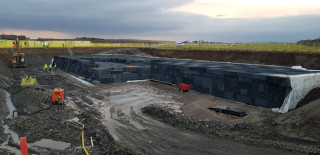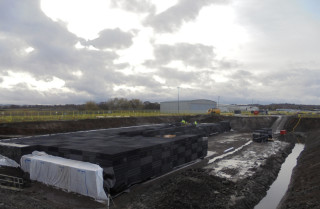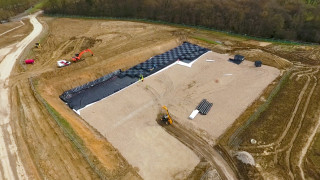With passenger numbers forecast to grow from around 14.5 million in 2017 to almost 20 million a year by 2021, Edinburgh Airport is in the throes of an ambitious £220m capital investment programme.
The latest phase in the expansion programme – an £80m terminal extension providing six new gates plus more space for customs & immigration and commercial use, was officially opened by Scotland’s first minister Nicola Sturgeon in June this year.
Alongside this is the recently-completed £23m Edinburgh Airport Stands Development, a 42-week civil engineering package to create 13 new aircraft stands plus new taxiways and an equipment area.
The main contractor for this is Wembley-based Careys Civil Engineering which, in addition to a large volume of concrete and asphalt paving, has had to install an extensive drainage system to cope with the run-off from the aircraft washing area as well as rainwater falling on the 75,000m2 of paved surfaces.
And of course, today’s drainage systems can’t just channel all that run-off into nearby watercourses or the sewer system. It has to be managed to prevent pollution and flash-flooding during periods of heavy rainfall. And a paved area of this magnitude requires some means of storing flood-water temporarily before discharging it into the environment.
At Edinburgh Airport, this was achieved by installing what is believed to be Scotland’s largest underground surface water drainage system in an excavation measuring 72m long, 32m wide and 3.25m deep.
“When the job was first tendered, the design [by consulting engineer Amey] specified a concrete tank. But Careys won the contract with an alternative proposal incorporating our design,” says Richard Averley, sales and marketing director with Somerset-based drainage manufacturer Sustainable Drainage Systems (SDS).
SDS doesn’t do concrete tanks; the design Averley refers to is an enormous attenuation tank made from the company’s Geolight geo-cellular plastic modules.
Geolight modules are made from 95% post-consumer recycled PVC waste – a material that was traditionally sent to landfill – and comprise a highly permeable honeycomb structure with a void ratio of over 95% to maximise water storage capacity.
“We receive the raw material in the form of calendared sheets which we process in a thermo-forming machine at our factory in Somerset,” explains Averley.
SDS’s Geolight units differ significantly from other cellular plastic products such as those produced by Wavin and Polypipe, which are injection-moulded and made from either polyethylene or polypropylene. “We are the only firm to use PVC for this type of product,” says Averley. He also says that SDS is Europe’s biggest single consumer of grade B recycled PVC.
The Geolight modules work differently from other plastic void-forming systems, too. “The other products are voided crate – or open – systems where the water flows in and sloshes about,” says Averley. “Ours is a distributed system with a limited discharge from the incoming pipe into the tank.”

The Geolight attenuation tank is located under an unused grassy area on the landside of the airport approximately 20m to the south of the new stands area. Surface water, predicted to run off the newly-created impermeable surface at flows of up to 3,000 litres/second, is collected via a gravity network of heavy-duty slot drains and a 660m-long run of 1,500mm-diameter pipes before being fed, via a single 1,500mm pipe, to the attenuation tank
The system is designed to hold back almost 7,000m3 of surface water during heavy storms and the amount of water leaving the Geolight storage tank is carefully controlled by a pumping station so that it can be discharged safely into the Edinburgh Airport network.
Careys Civil Engineering’s senior project manager, Allan Crozier, explains why the SDS system was chosen:
“Given the size, the only potential solutions were either a concrete tank or modular crate storage. Installing a concrete tank would have posed significant civil engineering challenges. With a tight programme, specifying SDS modular storage offered the advantage of both buildability and speed.
“Although on smaller schemes we do sometimes install storage crates ourselves, working with SDS meant we could hand over the installation of the tank to them. The SDS team were totally self-sufficient and extremely slick.” It took only seven weeks to complete the installation, he says.
On most projects only two people are required to install the units as the 2m x 1m x 0.5m cellular Geolight modules are easily handled. But on an installation of this scale, more people are required and SDS had up to six people working full-time on the installation.
The amount of space available for storage of materials on site was minimal and so SDS planned deliveries according to the capability of the team to install on site that day.
Careys prepared the site, stockpiling the excavated soil nearby and leaving a wide excavation with battered sides which required no shoring and allowed about one metre of working space around the perimeter of the tank’s footprint.

The Geolight units were assembled progressively from one end of the excavation to the other with Careys following at a safe distance, back-filling as it went. To seal the tank, the entire structure is wrapped in a 1mm-thick low-density polyethylene welded membrane.
“We deliver the membrane in sections but we do as many of the welds as possible in the factory first,” explains Averley. The final welds are done on site and are then subjected to a visual inspection to detect any gaps or leaks.
Once the installation was completed, the tank was capped with a 300mm layer of clean stone and a metre of soil from the original excavation. In this configuration the Geolight structure can support a surprisingly high loading, says Averley. “The honeycomb is one of the strongest structures in nature,” he declares.
“Once our tanks are in the ground and buried, they can take the weight of an aircraft,” says Averley. And while this installation isn’t expected to receive loadings of this magnitude, others are: “We did another tank at Birmingham Airport and that one had to be capable to taking the weight of an A380,” he adds.
Averley explains that the earth capping layer is crucial to the bearing capacity of a Geolight structure, spreading point loads efficiently so that one tonne applied over a square metre at the surface is distributed over 4m2 at a depth of one metre.
Further below the surface, lateral loadings become critical, so much so that different grades of Geolight unit were required to withstand the increased pressures.
Geolight is available in two standard load-ratings, 200 and 400kN/m2, with higher compressive strengths also available ranging from 600 to 1,000kN/m2. On this project SDS used a combination of 800, 600 and 400kN/m2 units.

Besides containing flood water and controlling its discharge, the Edinburgh Airport installation has also to be capable of removing contaminants that might pollute the environment.
A number of oil interceptors are positioned along the gravity network to clean the water before it enters the Geolight tank. The 1,500mm-diameter pipe feeding the tank is surrounded by a layer of clean stone to help filter out particles and, because the Geolight tank is not an open voided-crate design, water entering the tank is kept moving and there is far less sediment deposited inside it.
In time for the winter and any freezing weather conditions, Careys is constructing a system to hold surface water collected in the SDS Geolight tank if a sensor detects that it is contaminated with glycol anti-freeze. The polluted water will then be diverted into specially-designed storage tanks where it can be collected and disposed of correctly.
Although the Geolight tank won’t have any aircraft taxiing over it, there is potential for the area – currently grassed over – to be used for car parking in future. SDS has therefore installed another smaller tank as part of plans to extend the car parking facilities in a different part of the airport.

Bigger still...
The Geolight attenuation tank installed at Edinburgh Airport is big, but it’s not the biggest that SDS has ever installed.
That’s the tank at Stortford Fields, a major mixed-use development for Countryside Properties and East Herts District Council on a site just north of Bishop’s Stortford.
The scheme, due for completion in 2027, consists of around 2,200 new homes, both secondary and primary schools plus nursery, a care home, 1,000m2 of retail space and a business park.
Contractor Breheny Civil Engineering was tasked with supplying a site-wide sustainable drainage scheme linked to an existing watercourse to improve water levels and water quality as well as providing a riparian habitat with reed beds and increased plant diversity.
This required the installation of Geolight attenuation tanks located underneath the schools’ full-size football pitch and adjoining junior pitch.
With a capacity to store up to 8,000m3, or eight million litres, of water, this is believed to be the biggest surface water storage facility yet installed in the UK. It was completed in May 2018.
Got a story? Email news@theconstructionindex.co.uk





